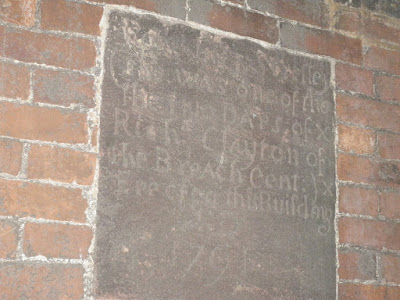A 29th great grandfather !!! But I’m not skiting.
Over several hours this week I added a few hundred Clayton people
to my tree.
They began as a “detached “lot (i.e. no direct relationship showed)
dating back to before the days of William the Conqueror. It all stems from the chance
finding of an Internet archive book called “The Clayton Family” by Henry F Hepburn
Esq LLB of Philadelphia PA. He had presented a paper about Clayton History in 1904. The book which was
digitised by the Internet Archive in 2008 can be found at http: //www.archive.Org/details/claytonfamily00hepb
Hepburn’s book begins with Robert to Clayton of Caudebec,
Normandy, accompanying William the Conqueror. Robert was a skilled soldier who
had been rewarded with the Manor of Clayton by William after his “laudable
services” in the Battle of Hastings. This came with titles and land around
Lancashire. So began a line of soldiers and Gentlemen farmers in the history
of England and included notable lawyers, medical practitioners and ministers in
the USA.
The tree additions continued as “detached” and “no direct
relationship” until Family Tree Maker program threw up a few questions such as "does this Robert Clayton born 1470 match the Robert Clayton in your tree?" With
caution prevailing I hold my breath until Jane Farrington matched too. A quick back up and person merge resulted in
all the detached relatives falling into place. The earliest relative being 27th
great-grandfather Robert de Clayton b 1030. Other information has shown that the line
starts two generations earlier with a man called Leosswine and son Hugh the
father Richard D Clayton. Yikes that’s a
29th great grandfather.
My interest in the Claytons stems from my Strelley connections
where my 4x great grandfather Robert Strelley married Elizabeth Clayton in 1768.
Interestingly Robert also descended from a Clayton where his grandmother Alice
Clayton married Thomas Robey in 1714. There is evidence in the book that the
families spread throughout England (and USA)
 |
| Robert Strelley 1739-1813 |
In 2014 I visited Waingroves Hall which was built by
Robert and Elizabeth around the 1800s. This was land in Derbyshire. I
discovered that the lands were brought to the Strelleys through Elizabeth’s
father Richard Clayton of Codnor Breach born 1696. It had a medieval history. The
land around Waingroves was developed in 1791 as a Squire’s Hall together with lake,
woodlands, orchards and the accompanying farm. When I visited in 2014 there was
talk of a monument to Richard Clayton in an old brick barn which was off-limits
do it due to state of repair.
We sweet-talk the farmer who volunteered to take a few
snaps of the stone plaque set into the brickwork inside the rundown brick barn.
Under the foundation of the house is evidence of a stone
engraved with the cross of the Knights Hospitaliers. This is evidence of past
medieval owners (relatives of the Clayton’s?) whose original footprint was
covered by the new Waingroves Hall.
 |
| The wording on the plaque says "Robt and Eliz Strelley (who was one of the two DAPS (daughters?) of X Richd Clayton of the (Codnor) Breach Gent:)X Erected this Building 1791" |
Whether this was Clayton land back in the 1400s is still
open to speculation. My Ancestry tree is constantly being fleshed out with more
anecdotal evidence and information on the female lines. Hepburn’s work
documents the male inheritance from the days of the land grants in 1066. However, as was the usual practice he excludes the female children
and the wives who may have brought land to their husbands through marriage. The
family originally had interest in land in Chester, Lancashire, York, Derbyshire
but spread throughout England.
Through my interest in DNA I have begun researching when
family lines left England and went to the New World. Hepburn’s paper was
presented in 1904 in Delaware and documents also the family history in Virginia,
Pennsylvania and Delaware. I need to bone up on Quaker history. Interestingly Hepburn
has also documented the Mainwaring family which dates even further back in
French history. Mary Mainwaring married John de Clayton in 1440 -a job on my
list for 2019.
All in all, not a bad find. Yes it brings out the disbelievers
and the “I’ll top you “ skiters but just
remember I’ve been there before with my Strelley family. I'll see you one and raise you. I love my hobby.
#skitingnotskiting
#29greatgrandfathers
Tip of the day: For Family Tree Maker users- If you find an ancient line and want to
work through it to find a connection its easier and quicker to work from
earlier to later. Simply add the first person
as father to anyone on your tree. Then detach the father from the family. He and
anyone added from there will show as no direct relationship. When you find a
corresponding matching person down in your tree make a backup and merge the two
common people. Relationship should then show.
Tip of the Day 2: I use an App called We’re Related by Ancestry. It connects you to “compilations” of famous
people’s trees and shows you a pathway to your famous relative. Occasionally this
is a hint to extend your tree upwards and most often takes your ancestor from
England to America. You need to check the pathway for errors. In this case I was following a lead to the
famous pastor, John Wesley b1703 and it led me to explore the Clayton mother in
laws and off on a tangent I went!




Hello! Not sure how else to get in touch with you - I found this page after tracing my direct geneology to Robert Clayton and Jane Tarrington (Farrington)? I am Sophie Clayton, the daughter of Stephen Clayton, who's father is Frank Clayton, who's father is Samuel Bateson Clayton (1914), etc. traced back to those in your post. I'd be interested in speaking with you. Please do contact me at sjc.tech@hotmail.co.uk Thank you!
ReplyDelete